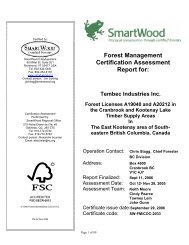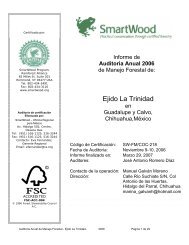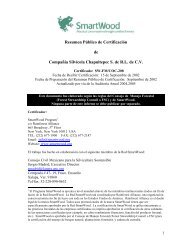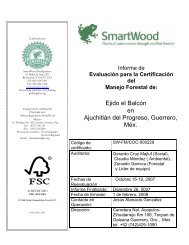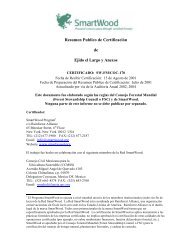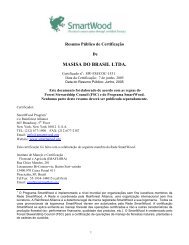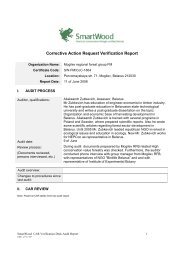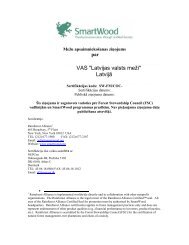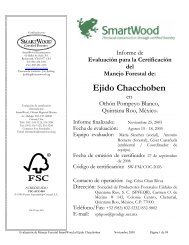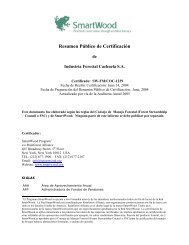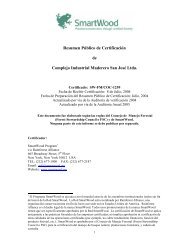[C] The Hidden Frontier of Forest Degradation - Rainforest Alliance
[C] The Hidden Frontier of Forest Degradation - Rainforest Alliance
[C] The Hidden Frontier of Forest Degradation - Rainforest Alliance
Create successful ePaper yourself
Turn your PDF publications into a flip-book with our unique Google optimized e-Paper software.
FIGURE 2. Stylized example <strong>of</strong> interactions between degradation processes leading to conversion. <strong>The</strong> order and nature <strong>of</strong> these transitions depends upon<br />
location. For example, in Indonesia, the “ranching” phase may instead be palm oil, or another tree crop.<br />
emissions,” that is all the emissions that are certain to occur<br />
eventually as a result <strong>of</strong> a given degradation activity (Putz<br />
et al., 2008). For example, the majority <strong>of</strong> emissions from<br />
selective logging activities generally come from dead trees<br />
left in the forest that rot or burn years after the actual logging<br />
event.<br />
2. <strong>Forest</strong> re-growth: Some studies account for “net” emissions<br />
from logging by subtracting the expected increase in tree<br />
growth and sequestration rates after logging events from<br />
the emissions (Houghton 2003). Others do not make this<br />
“growth <strong>of</strong>fset” subtraction (Putz et al., 2008).<br />
3. Lumping <strong>Degradation</strong> with Deforestation: Some deforestation<br />
estimates include some degradation emissions because<br />
they assume that forests being cleared are not degraded,<br />
even though forests are <strong>of</strong>ten degraded before they are<br />
converted. This problem results in underestimates <strong>of</strong><br />
degradation emissions and complicates full accounting <strong>of</strong><br />
emissions from deforestation and degradation. <strong>The</strong> critical<br />
issue is to avoid double counting <strong>of</strong> emissions when adding<br />
estimates <strong>of</strong> deforestation and forest degradation.<br />
<strong>The</strong> problem <strong>of</strong> lumping emissions from degradation with<br />
those from deforestation may be greatest where degradation<br />
acts as a catalyst for deforestation. It is these situations where<br />
it is particularly important to identify emissions from degradation<br />
so that REDD incentives can be directed to the first<br />
step in the chain reaction <strong>of</strong> land use change.<br />
Despite these challenges, from our review <strong>of</strong> (i) regional<br />
studies from all the major tropical forest zones finding that<br />
forest degradation emissions from logging, fire, and fuelwood<br />
collection represent 20-57 percent <strong>of</strong> forest emissions, (ii) a<br />
pan-tropical study on emissions from legal logging (Putz et. al.<br />
2008), and (iii) the limitations <strong>of</strong> global remote sensing analyses<br />
in detecting degradation, we infer that emissions from<br />
tropical forest degradation represent at least 20 percent <strong>of</strong><br />
total tropical forest emissions, the low end <strong>of</strong> the regional<br />
studies. While more research is needed to identify a single<br />
value for the magnitude <strong>of</strong> degradation emissions, we are suggesting<br />
that the studies referenced by the IPCC (Nabuurs et<br />
al., 2007), reporting that degradation emissions represent less<br />
than 10 percent <strong>of</strong> forest emissions, are making a conservative<br />
underestimate.<br />
T H E H I D D E N F R O N T I E R O F F O R E S T D E G R A D A T I O N $ 11


![[C] The Hidden Frontier of Forest Degradation - Rainforest Alliance](https://img.yumpu.com/30611265/15/500x640/c-the-hidden-frontier-of-forest-degradation-rainforest-alliance.jpg)
